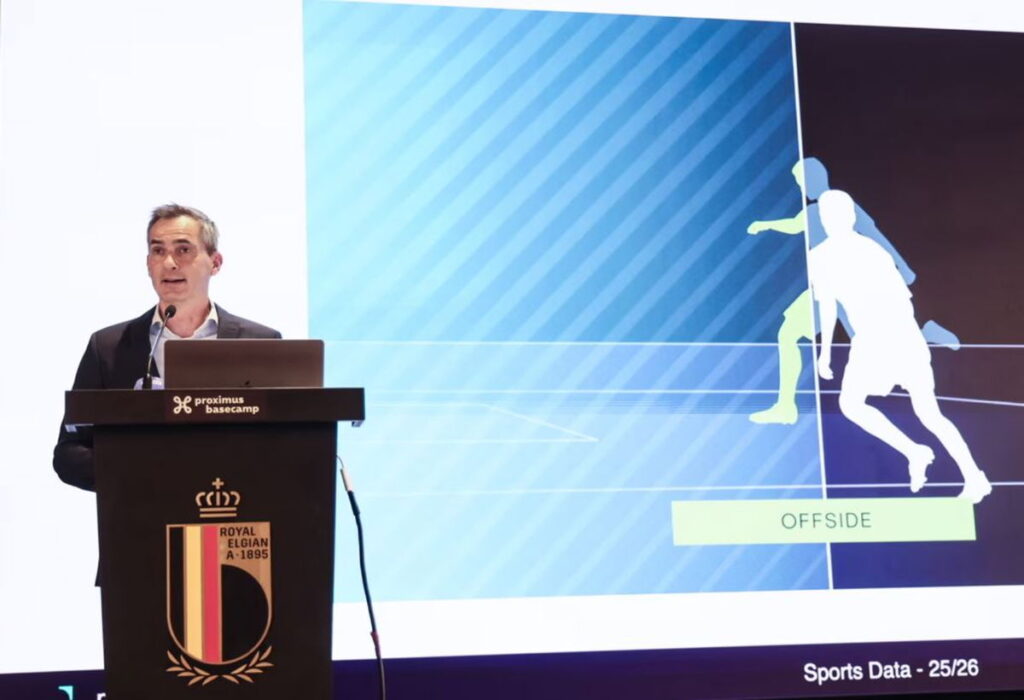
SAOT was presented in Belgium yesterday and it will be used in the 2025-20026 football season | Credits: Shutterstock
Belgian professional football will, in the upcoming 2025-2026 season, introduce a 15 million-euro upgrade for offside rulings known as semi-automatic offside technology (SAOT), according to the Belga News Agency.
The new technology has been described as a significant blow to controversial offside plays, thanks to the introduction of SAOT, which the Royal Belgian Football Association (RBFA) and the Pro League presented in Tubize.
This move in Belgian football is not an isolated one, but rather a part of a global trend. It champions accuracy and speed in refereeing. It also marks a pivotal moment for domestic football, aligning with the direction of the sport worldwide. This technology arrived in Belgium following high-profile trials in global tournaments and leading European leagues.
SAOT, first introduced in 2022 by FIFA
FIFA first introduced SAOT at the 2022 World Cup in Qatar and the Arab Club World Cup before it earned its place in UEFA competitions and elite domestic leagues, such as Serie A, La Liga this season, and the Champions League from the 2022/23 season, according to several news outlets, including Talksport. The Premier League also introduced the system in April of this year.
Semi-automated offside works by harnessing dozens of high-speed tracking cameras installed beneath stadium roofs to create a three-dimensional skeleton model of players.
These cameras feed data at around 50 frames per second, tracking up to 29 body points per player. An inertial sensor inside the match ball is also monitored, allowing AI to instantly establish the exact moment a pass is made, according to a FIFA report.
The combined information triggers an AI alert in the VAR room whenever a potential offside is detected. A video assistant then validates the automated offside line before relaying a decision to the referee on the pitch. Importantly, final rulings remain in the hands of match officials, not machines, ensuring a human touch in the game.
Preserving pace of game and fan engagement
The drive behind SAOT is clear: reduce VAR delays and eliminate successive millimetre judgments based on two-dimensional lines drawn from flat TV angles.
At the 2022 World Cup, the system slashed offside decision times by around 30 seconds, while at this year’s Club World Cup, one correct offside call was made in under 20 seconds. Premier League officials confirmed a typical reduction of 31 seconds per call, demonstrating the significant impact of the new technology on the game’s pace.
Belgium’s embrace of the technology marks a step in aligning its leagues with top-tier standards. Semi-automated offside removes variations introduced by frame rates and parallax, offering a definitive, 3D virtual visualisation that can also be shared with fans inside stadiums, offering much-needed transparency.
Referee chiefs and league officials argue that SAOT enhances trust in decisions while preserving the human touch essential to officiating.
FIFA‘s Pierluigi Collina was adamant during the Club World Cup trials that this remains a support tool, not a replacement for referees. UEFA’s use at Euro 2024 extends further aid via “connected ball” tech aimed at faster handball and penalty decisions.
Hybrid approaches to offsides
Other countries have adopted hybrid offside ruling models. Turkey’s Süper Lig introduced SAOT in stadiums midway through its season. The Premier League faced delays, with critics citing concerns over technological readiness and caution against prematurely implementing VAR decisions.
In contrast, leagues like Serie A and La Liga proceeded eagerly, welcoming clearer rulings from the outset of the season. Yet debates remain alive. Critics argue that the spirit of the offside rule—as in rugby, where forward passes are judged in centimetres—relies on human interpretation, not robotic precision.
Other football experts believe that zero-margin decisions transform the game, eliminating the human element of judgment, controversy, and debate, while also risking the core pillar of the game’s natural flow.
Still, the balance is tilting toward tech support, not tech domination. Belgium’s decision reflects a global reality: football is embracing tools that sharpen accuracy without erasing human oversight.
SAOT keeps emotions high on the pitch while trusting minds guide the verdicts. Belgium’s adoption of SAOT is part of a global trend towards embracing technology in football.
This is not just about faster calls, however. The introduction of automatic offline rulings is part of the football community’s broader commitment to greater fairness and fan engagement. It provides controversy-free rulings, ensuring the game’s pace and rhythm continue unaffected.






